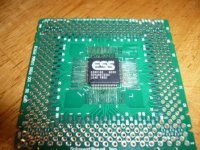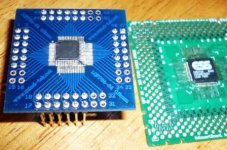Re: Buffalo option
You want to use one DAC to feed another DAC? Can you more clearly express what you want to do?
If you are looking for someone for testing, you should probably say where you live and ask if anyone living close has a Buffalo-32s, just to keep the shipping fees reasonable.
Kurt
Lucifix said:... I've allready designed the DAC4392 board which I want to use it to feed my future ESS DAC ...
You want to use one DAC to feed another DAC? Can you more clearly express what you want to do?
If you are looking for someone for testing, you should probably say where you live and ask if anyone living close has a Buffalo-32s, just to keep the shipping fees reasonable.
Kurt
Hello Javin5,You want to use one DAC to feed another DAC? Can you more clearly express what you want to do?
my board is a Digital Audio Converter and provides I2S signals at output so it must be connected to one (or more) Digital to Analog Converter chip (and adjacent HW) to listen some music from it...
I admit that I want shipping fees to be low but there's not a priority for me. Anyway, is there anyone, perhaps who lives in Europe, and wants to try my board with buffalo - 32 free of charge and share impressions (public or private - his/her choice) ?
Best, L
OK, so what are you trying to test with your converter? The Buffalo 32s accepts either I2S or SPDIF (the Sabre chip has a built-in converter). As long as your I2S output works on any other converter (and I'm assuming that you tested this already, probably with different DACs), it should work on the Buffalo as well. If you want to test the sonic qualities of the the 32s, you really should do that yourself, since other people may really have different preferences. I'm personally very satisfied with the sound.
Kurt
Kurt
@Javin5: You're right, I've done few listening tests with my board feeding PCM179x DACs and I was very pleased about the sound... though, one friend of mine (with different audio setup) told me he can hear some gaps (?) in audio signals - when DAC4392 card is connected to Buffalo-32 EVM - probably caused by some missing samples in digital to analog reconstruction, as he suggests. Even if I did check the problem and made extensive tests but with TI's chips only (without any result regarding this problem) because I don't have any ESS ES9018 EVM arround to play with, I though it could be better to ask for help in another place and seek for an transparent, objective opinion from other peoples who aren't involved solving the issue. As You've said, "other people may really have different preferences", unfortunately I'm included here so, no matter how much I try I cannot be as objective as I wanted. BTW: I suppose that you have one Buffalo-32 board arround to play with, don't You? 
@Brian: yes, I know from datasheet, thank you!
A beautiful day to all!
L
@Brian: yes, I know from datasheet, thank you!
A beautiful day to all!
L
Lucifix said:... I suppose that you have one Buffalo-32 board arround to play with, don't You?
Yes I do. However, I have only available SPDIF from a CD-player (optical and coax), and only 16/44.1. In fact, I have not yet used the I2S input of the Buffalo-32s so far. Whoever tests your board should have a variety of signal sources and signal formats available, including high bit rate.
Kurt
Not at all! I've allready done that: different DAC chips (mostly TIs) wired to this board and feeded by signals with various sample rates/ bit depths... anyway, ESS is still not in the list yet.Whoever tests your board should have a variety of signal sources and signal formats available, including high bit rate.

I suppose your/any 16/44.1 source should be enough... for the begining.
Here's my Sabre ES9018 Tweakers Board
Total Cost $70 - ES9018 $60 & Prototype Board $10
I used a SchmartBoard which has solder grooves into which the pins of the 64 QFP ES9018 sit making soldering by hand easy.
There is a ground plane on the bottom of the board & I will be running this on batteries so each Sabre analog & digital supply from a separate battery (4 batteries - DVCC_T; DVCC_B; AVCC_L; AVCC_R) & each 1.2V from an eneloop battery (3 batteries) - no regulators, just caps.
Edit: I had a bit of a moment with this ESS chip - I dropped it when opening the box I received it in & it must have fallen on it's corner because the pins on it's corner were bent out of line. This would have been impossible to solder without the SchmartBoard!
Total Cost $70 - ES9018 $60 & Prototype Board $10
I used a SchmartBoard which has solder grooves into which the pins of the 64 QFP ES9018 sit making soldering by hand easy.
There is a ground plane on the bottom of the board & I will be running this on batteries so each Sabre analog & digital supply from a separate battery (4 batteries - DVCC_T; DVCC_B; AVCC_L; AVCC_R) & each 1.2V from an eneloop battery (3 batteries) - no regulators, just caps.
Edit: I had a bit of a moment with this ESS chip - I dropped it when opening the box I received it in & it must have fallen on it's corner because the pins on it's corner were bent out of line. This would have been impossible to solder without the SchmartBoard!
Attachments
A pic of a different prototype board again with an LQFP64 chip (TAS1020B) same package as the Sabre. This board does not have grooves for the pins to fit into but is just a standard board & was soldered by hand. So the Sabre could also be soldered to one of these (I didn't do this soldering, a fellow inmate did)
Attachments
It's not difficult to solder a chip to a protoboard.
It will work, but not at all well, because there is no good way to mount the caps close enough to the pins to be effective at 20-80mhz.
Also the way those traces are fanned out is going to be very bad for both the digital and analog signals.
If it were this simple one would not bother designing a PCB.
Don't take this the wrong way, I hope you have great time with your project.
Just curious, what does this have to do with the Buffalo in the least? Not any old thing with an ESS chip soldered on it qualifies.
Cheers!
Russ
It will work, but not at all well, because there is no good way to mount the caps close enough to the pins to be effective at 20-80mhz.
Also the way those traces are fanned out is going to be very bad for both the digital and analog signals.
If it were this simple one would not bother designing a PCB.
Don't take this the wrong way, I hope you have great time with your project.
Just curious, what does this have to do with the Buffalo in the least? Not any old thing with an ESS chip soldered on it qualifies.
Cheers!
Russ
Russ, you could be right, then again you could be wrong - at least I have an open mind about it & it hasn't cost me $569 to find out!!
You are very quick to point out why it wont work but I have some tricks up my sleeve. Don't take this the wrong way but I started this thread & I consider this post to be a relevant departure - perhaps I'll start another thread!
It will be interesting to compare it to a Buffalo which a friend has!
You are very quick to point out why it wont work but I have some tricks up my sleeve. Don't take this the wrong way but I started this thread & I consider this post to be a relevant departure - perhaps I'll start another thread!
It will be interesting to compare it to a Buffalo which a friend has!
jkeny said:Russ, you could be right, then again you could be wrong - at least I have an open mind about it!
Ah, an open mind. Excellent, then I trust this is sinking in.
Indeed, wrong I have been many times, but I am quite certain of the facts involved here. There is no working around the laws of physics regardless your skillful trickery up your vestments.
Prototype boards are designed for - this is profound - prototypes. Prototypes are good for investigating new chips or trying out ideas. If that's you aim, your spot on. If you want quality, your barking up the wrong tree.
Happy protoyping.
jkeny said:Russ, no need to get all prickly - this is a DIY forum or have you forgotten that - nuff said!
Prickly?
DIY indeed. Precisely why I love this place. I feel confident I have contributed more than many (but far less than some) precisely because I enjoy and appreciate DIY efforts. So best wishes and have fun.
What I contribute I contribute for fun.
Cheers!
Russ
jkeny said:Russ, no need to get all prickly - this is a DIY forum or have you forgotten that - nuff said!
No prickliness evident in Russ' reply - he's just telling you some straight facts - for example about decoupling - which you probably are loathe to hear. Given those long traces to the DAC on your protoboard, why would you bother with battery supplies at all, since all the parasitic inductance will create plenty of undesirable PSU noise?
Neither Russ nor I would wish to stop you from making your own mistakes, so please do go ahead and report back...
mikelm said:Hey Guys,
This thread doesn't seem very friendly just now
not much fun for the rest of us witnessing ur conversation
Both Russ and I are telling it like it is. That's friendly even if there are others who don't want to listen. If you don't enjoy being exposed to the facts, there are plenty of other things in this world for you to get up to - no need to stick around here!
- Status
- This old topic is closed. If you want to reopen this topic, contact a moderator using the "Report Post" button.
- Home
- Source & Line
- Digital Line Level
- Buffalo Tweaking

